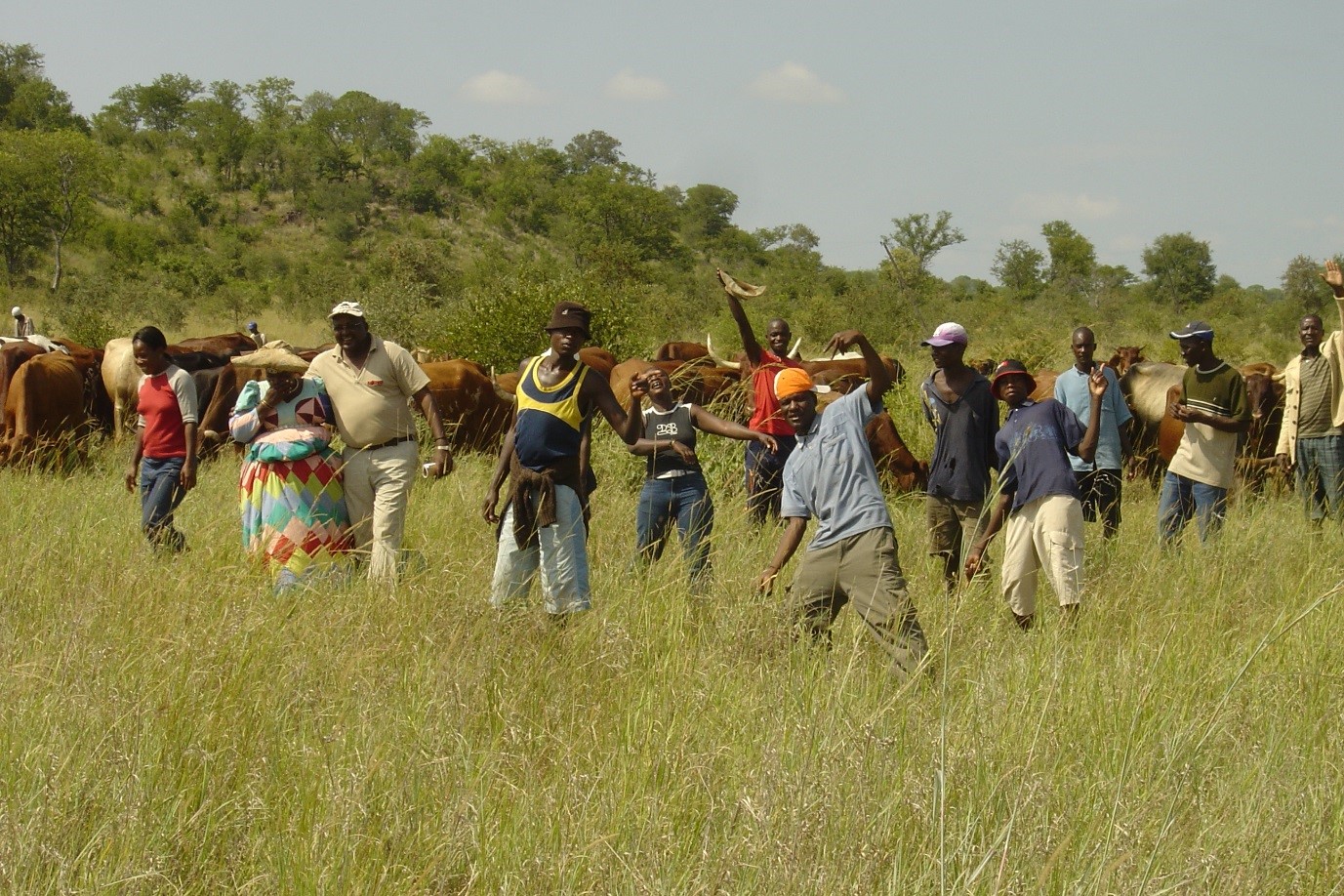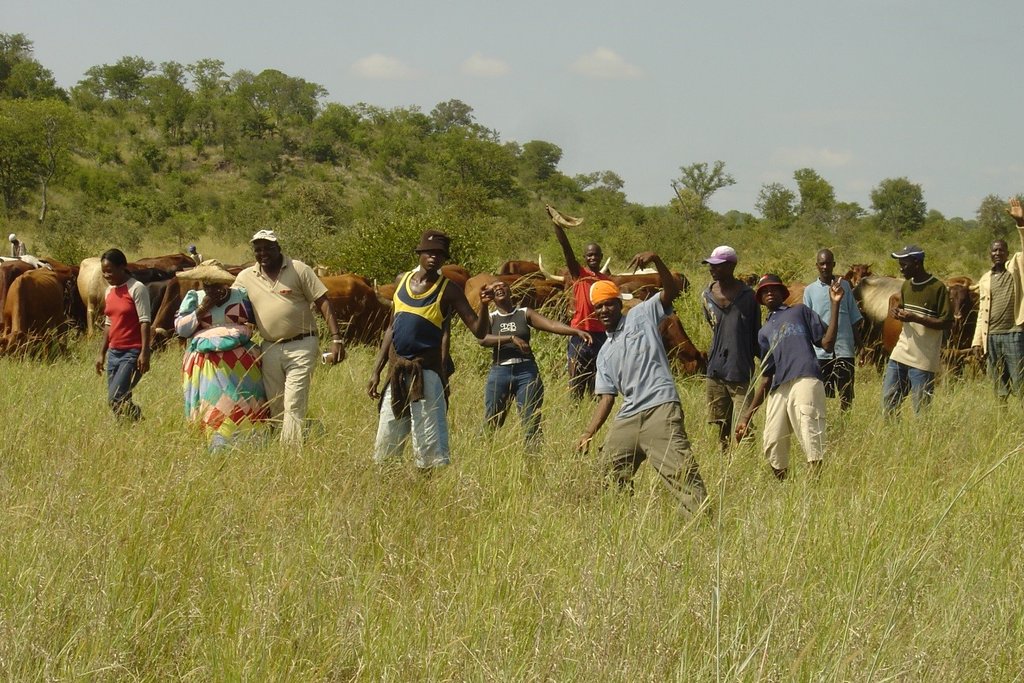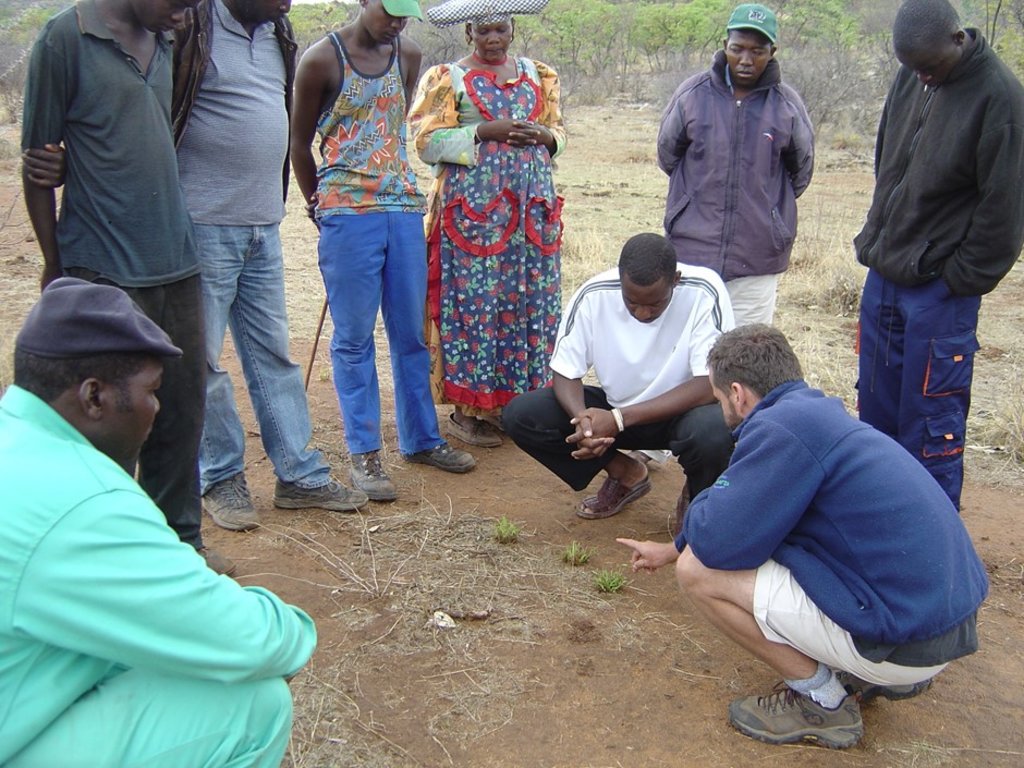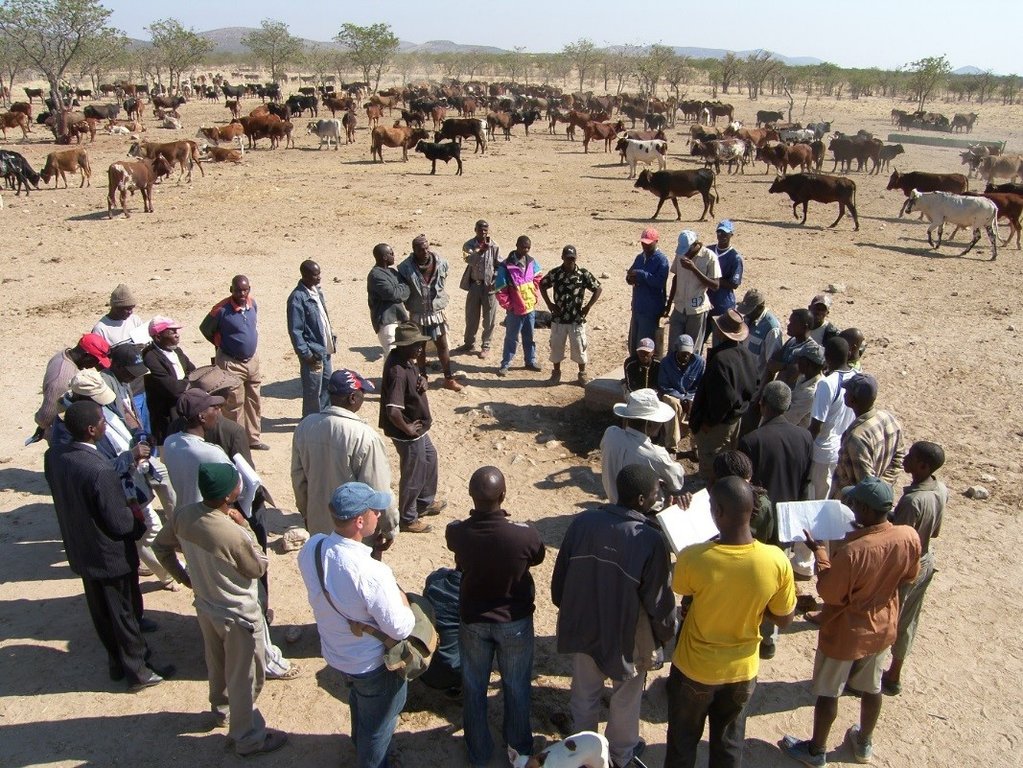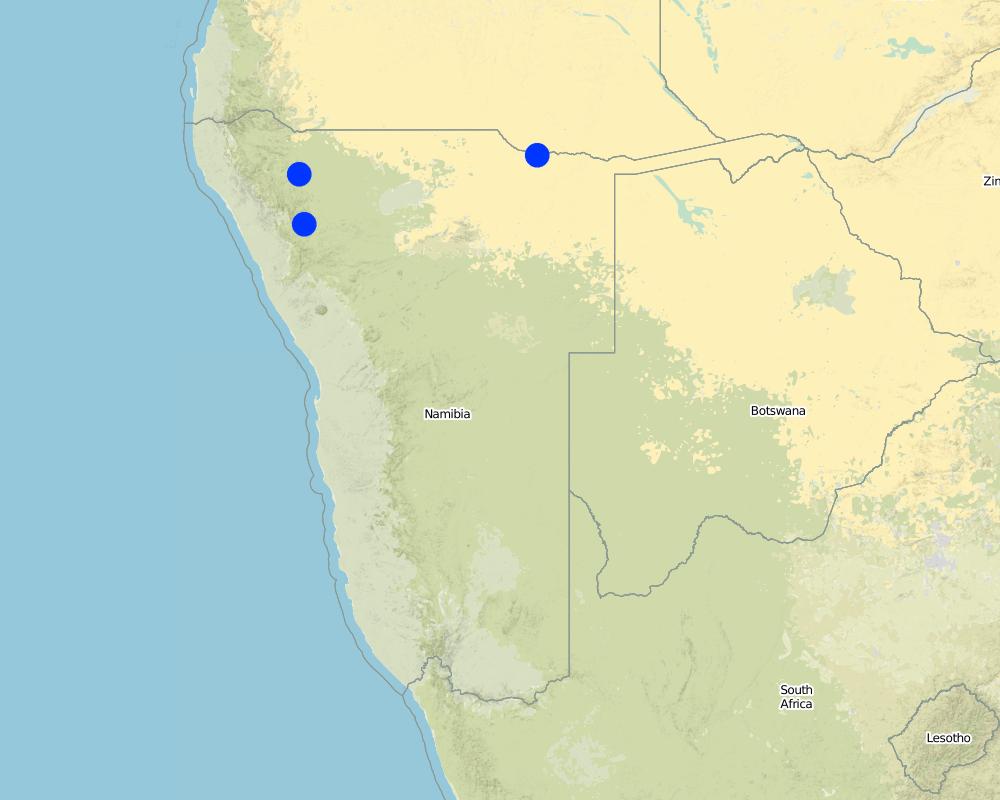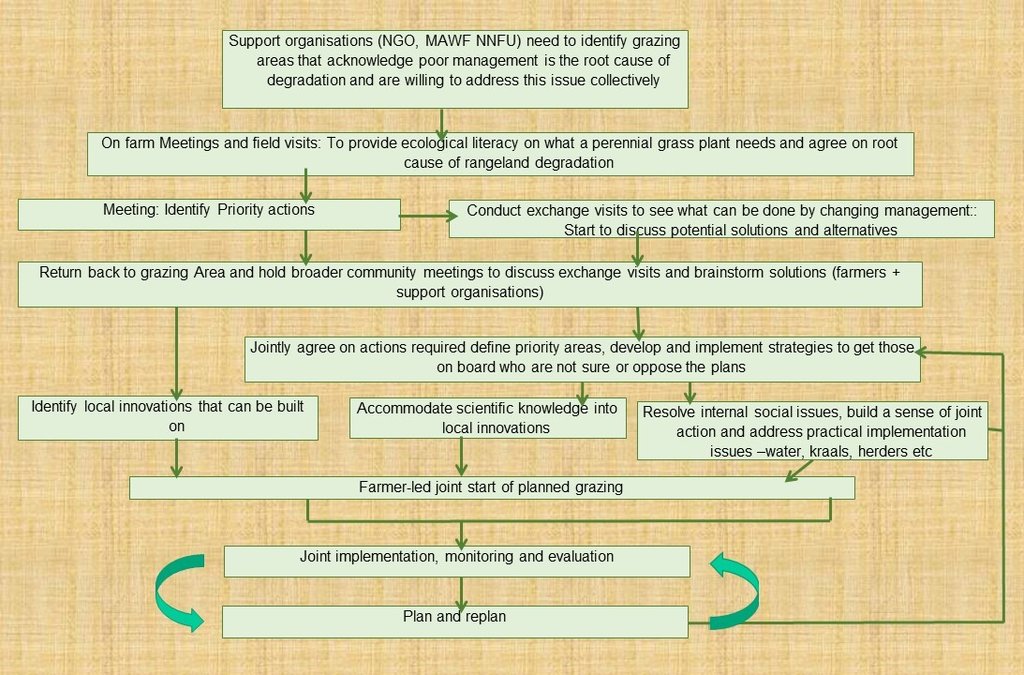Commuity grazing management [Намибия]
- Создание:
- Обновить:
- Составитель: Ibo Zimmermann
- Редактор: –
- Рецензент: Rima Mekdaschi Studer
Omarisiro wovinamuinjo motjimbumba
approaches_3050 - Намибия
Просмотреть разделы
Развернуть все Свернуть все1. Общая информация
1.2 Контактные данные специалистов и организаций, участвующих в описании и оценке Подхода
землепользователь:
Название проекта, содействовавшего документированию/оценке Подхода (если применимо)
Southern African Science Service Centre for climate change and Adaptive Land management (SASSCAL)Название организации (-ий), содействовавших документированию/оценке Подхода (если применимо)
Conservation Agriculture Namibia (Conservation Agriculture Namibia) - НамибияНазвание организации (-ий), содействовавших документированию/оценке Подхода (если применимо)
Zakumuka Producers Co-operative (Zakumuka Producers Co-operative) - Намибия1.3 Условия, регламентирующие использование собранных ВОКАТ данных
Когда были собраны данные (на местах)?
2017
Составитель и ответственный/-ые специалист(-ы) согласны с условиями, регламентирующими использование собранных ВОКАТ данных:
Да
1.4 Ссылка (-и) на Анкету (-ы) по Технологиям УЗП
2. Описание Подхода УЗП
2.1 Краткое описание Подхода
Agreement among community members to jointly manage their communal grazing area by combining their livestock into a single herd. The herd is managed and moved according to an agreed growing season plan that provides sufficient recovery for perennial grasses, and a non-growing season plan to graze in a way that prepares soil and plants for the next season. Regenerating rangeland productivity and well-being is the goal.
2.2 Подробное описание Подхода
Подробное описание Подхода:
The approach is a partnership between an NGO, Ministry of Land Reform (MLR), Ministry of Agriculture , Water and Forestry (MAWF), the National Farmers Union (NNFU), traditional authorities, and regional and local government. The NGO raises awareness among the community about the damage caused to the rangeland by individual herds of livestock grazing continuously – and to appreciate the benefits of planned grazing. Livestock owners invite facilitators to compare the current state of their land with that of the past. The reasons for the decline are investigated. Once livestock owners understand that perennial grasses need recovery, they soon conclude that their management caused the loss of perennial grass and the increase in bare ground. At this point, the aim of the approach can be pursued. This is to regenerate rangeland productivity in the communal grazing area and thereby support higher livestock production. This in turn supports livelihoods.
If motivation to apply planned grazing exists among the community members, then their right to claim common property ownership needs to be established. In pioneering communities this requires at least 10 village level livestock owner meetings to decide on modalities of planned grazing. These meetings continue after planned grazing has started to deal with ongoing planning, animal production and marketing. Exposure visits to areas with successful grazing management help. On return frequent follow-up meetings, facilitated by the NGO and the MAWF, can resolve local issues, including traditional taboos, such as combining animals in one kraal, and whose bulls should be kept and managed.
Boundaries with neighbouring communities need to be mapped, recognised and respected by all. In case of grass poaching, the offenders must to be swiftly dealt with, preferably through customary law. A grazing plan needs to be agreed by all livestock owners, and endorsed by the local Traditional Authority. The grazing area (GA) is then mapped, while six herders, one of whom is their manager, are appointed from among the community though common agreement. Each livestock owner pays a portion of the herding and management cost pro-rata based on the number of his livestock. At night the cattle are separated and kraaled near the homesteads of their owners. In the morning, the herders collect cattle from the kraals. Different portions of the grazing area are grazed daily and only returned to when the grass has replenished its root reserves - some months later.
The process started at Erora in 2004, facilitated by the NGO, Integrated Rural Development and Nature Conservation (IRDNC). Implementation began in 2006, combining approximately 1200 cattle from 12 households. Livestock owners noticed a higher density of annual grasses after the first season; dramatic improvement in soil cover after three years with emergence of grass seedlings where none had grown for decades. Then after another three years, perennial grasses returned with increased biodiversity in many parts. However, when the extended drought started in 2011, planned grazing was interrupted and gullies expanded, down which rainwater flowed, dehydrating the rangelands. The drought lasted for five years, and the planned grazing was temporarily discontinued in 2013. During this period, rehabilitation work included constructing bush filters along key gullies: facilitation was taken over by another NGO, Conservation Agriculture Namibia (CAN). After successive years of severe drought, cattle became too weak to be rounded up, and in 2014 the community members decided to revert to keeping cattle near their homesteads. This was intended to be temporary but cattle only gained sufficient strength in 2017. The communal grazing management approach was extended to other villages in 2012, despite the drought. New boreholes were drilled and installed to facilitate improved planned grazing.
2.3 Фотографии, иллюстрирующие Подход
2.4 Видеоматериалы по применению Подхода
Комментарий, краткое описание:
www.youtube.com/watch?v=xNyFkDUH6MQ
This video is from a DVD created by the Integrated Rural Development and Nature Conservation (IRDNC), a Namibian NGO and co-sponsored by the Namibian Ministry of Agriculture and the Namibian National Farmers Union. The video documents the development of a rangeland program focused on Holistic Management, spearheaded by Colin Nott, a Holistic Management educator.
Дата:
2007
Место:
Erora, Namibia
Автор съемки:
Andrew Botelle
Комментарий, краткое описание:
www.youtube.com/watch?v=3Ey5v40KtkI
Combined herding to manage communal grazing with the use of stress-free handling of cattle,
Дата:
2007
Место:
Erora, Namibia
Автор съемки:
Andrew Botelle
Комментарий, краткое описание:
www.youtube.com/watch?v=6C4V_Cib8ts
Managing water flow to repair gully erosion
Дата:
2015
Место:
Namibia
Автор съемки:
Andrew Botelle
2.5 Страна/ регион/ место, где применялся Подход
Страна:
Намибия
Административная единица (Район/Область):
Kunene Region
Более точная привязка места:
Erora village, 18.32637 South, 14.05912 East
Map
×2.6 Даты начала и окончания реализации Подхода
Год начала реализации:
2004
Комментарии:
Combined herding was discontinued at Erora in 2013 due to extreme drought, which ended in 2016/2017 rainy season, and land users are planning to use reserved grazing, whereby cattle are taken out each day by herders and left there to return on their own to water points. In the meantime, combined herding has already resumed at the Outokotorua grazing area.
2.7 Тип Подхода
- Science informs the traditional practice
2.8 Каковы цели/ задачи Подхода
To regenerate rangeland productivity for supporting livelihoods and improved quality of life.
2.9 Условия содействующие применению Технологии/ Технологий в рамках Подхода или затрудняющие его
Социальные/ культурные/ религиозные нормы и ценности
- содействуют
Herding is customary, and the task is now shared among families
- затрудняют
Herding no longer carries the high social status that it had previously.
Наличие/ доступность финансовых ресурсов и услуг
- содействуют
No bought inputs are required, and fewer herders needed than with many small herds. Also fewer losses from stock theft and predators
Институциональные условия
- содействуют
A grazing area committee was established with support of livestock owners
- затрудняют
The grazing area committee is not legally recognised
Сотрудничество/ координация действий
- содействуют
Partnership approach with MLR, Ministry of Agriculture, Water and Forestry (MAWF) the NNFU, traditional authorities and regional and local government.
- затрудняют
Resolution of local issues to apply grazing plans needs to be resolved
Нормативно-правовая база (землевладение, права на земле- и водопользование)
- содействуют
National Policy and strategy is in place which supports sound management principles
- затрудняют
Grass poaching by neighbouring communities is not adequately dealt with by the law
Программные документы/ руководящие установки
- содействуют
The approach is based upon the Namibia National Rangeland Management Policy and Strategy
- затрудняют
Common property rights are insufficiently promoted
Управление земельными ресурсами (принятие решений, осуществление и контроль за выполнением)
- затрудняют
Lack of integration of different scales of management between conservancies at large scales and grazing areas at smaller scale is required
Осведомленность в области УЗП, доступность технической поддержки
- содействуют
The awareness exists among participating livestock owners and stakeholders
Рынки (для приобретения материалов и услуг, продажи продукции) и цены
- содействуют
The Namibia National Farmers Union is busy addressing markets north of the veterinary cordon fence, which maintains a zone free of foot-and-mouth disease to the south from where farmers are able to access the lucrative EU market
- затрудняют
During drought the drop in prices from sudden increase in supply, results in inability of farmers to sell livestock when sudden shortage of forage occurs
Объем работ, доступность рабочей силы
- содействуют
Fewer herders are required for one large herd than for many small herds
- затрудняют
The role of herders as rangeland managers lacks status and is not adequately appreciated, resulting in high turnover of trained herders and their manager.
другие
- затрудняют
One large livestock owner at a given place can hinder efforts of the majority to improve rangeland management
3. Участие и распределение ролей заинтересованных сторон
3.1 Заинтересованные стороны, участвующие в реализации Подхода и их роли
- местные землепользователи/ местные сообщества
Communities of Erora, Outokotorua and Nsindi
To organise, plan and implement
- организации местных сообществ
Grazing Committee
Oversee day to day implementation
- эксперты по УЗП/ сельскому хозяйству
Integrated Rural Development and Nature Conservation (IRDNC), then Conservation Agriculture Namibia (CAN) and Namibia National Farmers Union (NNFU)
To facilitate adoption and upscaling of the approach
- ученые-исследователи
United States Department of Agriculture (USDA)
To assess rangeland condition changes
- общественные организации
First IRDNC, then CAN
To facilitate the approach
- частный сектор
Zakumuka Producers Cooperative
To organise auctions for sale of livestock
- местные власти
Traditional authorities
To support and enable agreed rules
- государственные власти (отвечающие за планирование или принятие решений)
Namibian Ministries of Lands & Agriculture
Assist with facilitation and support
- Farmers union
Namibia National Farmers Union
Enabling policy and legislation
Если участвовало несколько заинтересованных сторон, назовите ведущую организацию:
Integrated Rural Development and Nature Conservation (IRDNC), taken over in 2014 by Conservation Agriculture Namibia (CAN)
3.2 Участие местных землепользователей/ местных сообществ на разных стадиях реализации Подхода
| Участие местных землепользователей/ местных сообществ | Перечислите участников и опишите их вовлеченность | |
|---|---|---|
| инициирование/ мотивация | интерактивное | The community, with focus on livestock owners, youth, women and herders, under facilitation by NGO by conducting exchange visits to neighbouring countries |
| планирование | интерактивное | Feedback was given to communities by participants of exchange visits, grazing committees appointed to contextualise and re-plan for the way forward under guidance of NGO, Ministry of Agriculture, Water and Forestry (MAWF) and Namibia National Farmers Union (NNFU) |
| выполнение | интерактивное | The grazing committee, livestock owners and herders carry out the grazing plan with support of NGO, MAWF and NNFU |
| мониторинг/ оценка | интерактивное | The grazing committee and livestock owners constantly plan and replan and evaluate results on livestock performance and rangeland and daily check where livestock have grazed and where they will graze next and feed results into re-planning. Annual assessments of forage in May, to determine stocking rate. |
| external assessment of data | внешняя поддержка | External assessment by researchers of data gathered by USDA through Innovations for Poverty Action (IPA) |
3.3 Схема реализации (если имеется)
3.4 Принятие решений по выбору Технологии/ Технологий УЗП
Укажите, кто принимал решение по выбору применяемой Технологии/ Технологий:
- в основном землепользователи при поддержке специалистов по УЗП
Поясните:
After exposure to sound management techniques and on farm identification and agreement on the root cause of the degradation – the farmers themselves decide if they will continue or not.
Поясните на чём было основано принятие решений:
- анализ подробно описанного опыта и знаний по УЗП (принятие решений на основе подтвержденных фактов)
- личный опыт и мнения (незадокументированные)
4. Техническая поддержка, повышение компетенций и управление знаниями
4.1 Повышение компетенций/ обучение
Проводилось ли обучение землепользователей/ других заинтересованных лиц?
Да
Укажите, кто проходил обучение:
- землепользователи
- местный персонал/консультанты
- Ministry of Agriculture, Namibia National Farmers Union.
Если существенно, укажите гендерный и возрастной состав, статус, этническую принадлежность и т.д.
Inclusion of youth, women and herders.
Тип обучения:
- в ходе работы
- обмен опытом между фермерами
- общие собрания
Рассматриваемые темы:
On farm(s) exploration of root cause of degradation based on how it was in the past and how it looks now and why this change has happened.
Комментарии:
A number of issues including: Rangeland management, focussing on the needs of grass plants and soil. Needs of herders, people and stakeholders and how these various needs can be met. Institutional support for grazing committee, focussing on budgeting and financial management.
4.2 Консультационные услуги
Есть ли у землепользователей возможность получать консультации?
Да
Укажите, где именно оказываются консультационные услуги:
- на полях землепользователей
- Visits to successful farmers
Описание/ комментарий:
Mostly through exchange visits, community meetings, on farm excursions and on-the-job training.
4.3 Институциональная (организационная) поддержка
В ходе реализации Подхода были ли организованы новые институциональные структуры или поддержаны уже существующие?
- да, существенно
Укажите уровень, на котором структуры были укреплены или вновь созданы:
- местные
- региональный
Опишите организацию, функции и ответственность, членство и т.д.
Grazing Committee guides and implements the grazing plans and support organisations including Ministry of Agriculture, Namibia National Farmers Union and NGOs provide support and advice.
Укажите тип поддержки:
- повышение компетенций/ обучение
- оборудование
Подробнее:
Exchange visits, facilitation of meetings and on-the-job training. Drilling and equipping of boreholes. Redesign of water supply for livestock and combined kraaling system.
4.4 Мониторинг и оценка
Являются ли мониторинг и оценка частью Подхода?
Да
Комментарии:
To support decision making
Если да, будет ли данный документ использоваться для мониторинга и оценки?
Нет
4.5 Научные исследования
Были ли научные исследования частью Подхода?
Да
Укажите темы исследований:
- социология
- экономика / маркетинг
- экология
Напишите подробнее и назовите тех, кто выполнял исследования:
USDA/IPA came to evaluate rangelands and consult key stakeholders
5. Финансирование и внешняя материальная поддержка
5.1 Годовой бюджет мероприятий по УЗП в рамках Подхода
Укажите годовой бюджет мероприятий УЗП в рамках Подхода в долларах США :
10000,00
Если точный годовой бюжет неизвестен, укажите примерный диапазон затрат:
- 10000-100000
Комментарий (например, основные источники финансирования/ ключевые доноры):
Major donor to initiate the project was Enagelica Entwikelins Diens (EED), through IRDNC and later funding came from the Millenium Challenge Account (MCA), the EU and now the Finnish Embassy through CAN. Cost is per grazing area for local level field facilitation.
5.2 Финансирование и внешняя материальная поддержка, предоставляемая землепользователям
Предоставлялась ли землепользователям финансовая/ материальная поддержка для применения Технологии /Технологий?
Да
Если да, укажите тип(-ы) поддержки, кто ее предоставил и условия предоставления:
Upgrades of boreholes, drilling and equipping of new boreholes that are elephant-proof and construction of lion-proof kraaling was funded through the NGO.
5.3 Субсидии на отдельные затраты (включая оплату труда)
- труд
| В какой степени | Опишите субсидии подробнее |
|---|---|
| профинансированы частично | Part payment to herders 2004-2007 in Erora only |
- другие
| Другой (какой именно) | В какой степени | Опишите субсидии подробнее |
|---|---|---|
| Boreholes and kraals | профинансированы частично | Erora upgrade USD 10 000, second solar borehole half funded by community USD 10 000. Lion proof kraal funded by Africat – USD 2 000 |
Если труд землепользователя был существенным вкладом, укажите, был ли этот вклад:
- за денежное вознаграждение
Комментарии:
Only for first four years at one of the villages to enable proof of concept to be established.
5.4 Кредитование
Предоставлялись ли в рамках Подхода кредиты на мероприятия УЗП?
Нет
5.5 Другие методы или инструменты стимулирования
Использовались ли другие методы или инструменты стимулирования для продвижения Технологий УЗП?
Нет
6. Анализ влияния и заключительные положения
6.1 Влияние Подхода
Сумел ли Подход расширить возможности местных землепользователей, повысить участие заинтересованных сторон?
- Нет
- Да, немного
- Да, умеренно
- Да, существенно
Through the whole approach.
Сумел ли Подход дать возможность принимать решения на основе подтвержденных фактов?
- Нет
- Да, немного
- Да, умеренно
- Да, существенно
Through observations by herders and livestock owners.
Сумел ли Подход помочь землепользователям внедрить и поддерживать технологии УЗП?
- Нет
- Да, немного
- Да, умеренно
- Да, существенно
Combined herding through planned grazing.
Сумел ли Подход улучшить согласованность действий и повысить рентабельность применения практик УЗП:
- Нет
- Да, немного
- Да, умеренно
- Да, существенно
Key stakeholders are all involved.
Сумел ли Подход мобилизовать/ расширить доступ к финансовым ресурсам для применения практик УЗП?
- Нет
- Да, немного
- Да, умеренно
- Да, существенно
Сумел ли Подход расширить знания и возможности землепользователей в применении практик УЗП?
- Нет
- Да, немного
- Да, умеренно
- Да, существенно
Training provided the skills to self organise and implement activities based upon identification of root cause of land degradation.
Сумел ли Подход расширить знания и возможности других заинтересованных сторон?
- Нет
- Да, немного
- Да, умеренно
- Да, существенно
Ministries of Agriculture and Lands.
Сумел ли Подход укрепить сотрудничество между заинтересоваными сторонами/ выстроить механизмы сотрудничества?
- Нет
- Да, немного
- Да, умеренно
- Да, существенно
Key stakeholders are all collaborating, since the solution to rangelands cuts across various sectors.
Сумел ли Подход снизить остроту конфликтов?
- Нет
- Да, немного
- Да, умеренно
- Да, существенно
Reinstated sense of community
Сумел ли Подход расширить возможности социально и экономически уязвимых групп?
- Нет
- Да, немного
- Да, умеренно
- Да, существенно
Women-headed households now have their livestock herded communally.
Сумел ли Подход содействать гендерному равенству и расширить права и возможности женщин и девочек?
- Нет
- Да, немного
- Да, умеренно
- Да, существенно
Women-headed households now have their livestock herded communally.
Сумел ли Подход стимулировать молодежь/ будущее поколение землепользователей заниматься УЗП?
- Нет
- Да, немного
- Да, умеренно
- Да, существенно
Herders are mainly youth and young livestock owners, who appreciate improved rangeland and are now willing to remain.
Сумел ли Подход разрешить правовые проблемы землевладения/ землепользования, препятствующие использованию технологий УЗП?
- Нет
- Да, немного
- Да, умеренно
- Да, существенно
The willingness to address appropriate land rights may initiate resolution of land issues.
Сумел ли Подход способствовать улучшению продовольственой безопасности/ качества питания?
- Нет
- Да, немного
- Да, умеренно
- Да, существенно
Much during good rains and little during drought.
Сумел ли Подход расширить доступ к рынкам?
- Нет
- Да, немного
- Да, умеренно
- Да, существенно
Сумел ли Подход улучшить санитарные условия и доступ к водоснабжению?
- Нет
- Да, немного
- Да, умеренно
- Да, существенно
Access to borehole water was provided.
Сумел ли Подход привести к более эффективному использованию электроэнергии/ возобновляемых источников энергии?
- Нет
- Да, немного
- Да, умеренно
- Да, существенно
Solar installations were installed or replaced diesel where possible for pumping of water.
Сумел ли Подход улучшить способность землепользователей адаптироваться к изменениям климата и смягчать последствия катастрофических погодных явлений?
- Нет
- Да, немного
- Да, умеренно
- Да, существенно
Improved grass growth in good rain years and improved survival in drought.
Сумел ли Подход привести к созданию новых рабочих мест/ к расширению возможностей получения дохода?
- Нет
- Да, немного
- Да, умеренно
- Да, существенно
Herders and managers were appointed.
6.2 Основные причины, побуждающие землепользователей внедрять УЗП
- рост продуктивности
Increased grass, higher calving and reduced mortalities.
- рост прибыли (доходности) и рентабельности
Increased grass, higher calving and reduced mortalities.
- снижение деградации земель
Changing unsustainable practices for improved resource base.
- снижение объёма работ
Fewer herders needed.
- престиж, общественное давление/ солидарность
Social cohesion to implement joint management.
- экологическая сознательность
To support the future of livestock in their area.
6.3 Долгосрочная устойчивость мероприятий в рамках Подхода
Могут ли землепользователи самостоятельно (без внешней поддержки) продолжать применение того, что было реализовано в рамках Подхода?
- да
Если да, опишите как:
They mobilise themselves, appoint herders, do the implementation, do the planning jointly and, and only asking for some technical support.
6.4 Сильные стороны/ преимущества Подхода
| Сильные стороны/ преимущества/ возможности по мнению землепользователей |
|---|
| By caring for the rangeland, farmers will have grass all year round and minimise effects of drought. |
| Сильные стороны/ преимущества/ возможности по мнению составителя или других ключевых специалистов |
|---|
| It has proven to improve the resource base if applied properly. |
| It is viable and upscalable. |
| It has diverse benefits for the land user, including economic, social and environmental. |
6.5 Слабые стороны/ недостатки Подхода и пути их преодоления
| Слабые стороны/ недостатки/ риски по мнению землепользователей | Возможные пути их преодоления/снижения? |
|---|---|
| If a new water point needs to be developed, then funds will be required | Convince land users that by selling one or a few cattle to invest in a new water point, they will realise the returns from increased productivity within a few years. |
| Слабые стороны/ недостатки/ риски по мнению составителя или ответственных специалистов | Возможные пути их преодоления/снижения? |
|---|---|
| The herding is hard work, the status of herders is perceived to be low and they are poorly compensated. |
Convince livestock owners that they can adequately afford to compensate the herders. Start national and regional vocational training in herding, grazing management, low-stress handling, animal health, rangeland management, water management and financial and farm management. |
7. Справочные материалы и ссылки
7.1 Методы сбора/источники информации
- выезды на места, полевые обследования
- опросы землепользователей
- опросы специалистов/экспертов по УЗП
7.2 Ссылки на опубликованные материалы
Название, автор, год публикации, ISBN:
Global case studies of grazing in nature’s image, Jim Howell, 2008, 1-4392-1610-X
Где опубликовано? Стоимость?
www.booksuge.com
7.3 Ссылки на материалы, доступные онлайн
Название/ описание:
Community based rangeland and livestock management
Адрес в сети Интернет:
https://rmportal.net/groups/cbrlm/cbrlm-for-review/namibia-community-based-rangeland-livestock-management-cbrlm-2nd-edition/view
Ссылки и модули
Развернуть все Свернуть всеСсылки
Нет ссылок
Модули
Нет модулей


